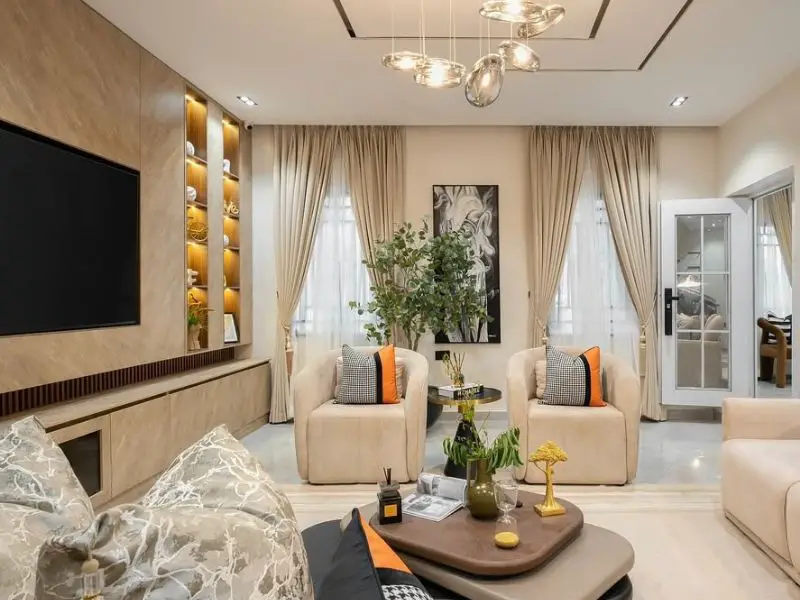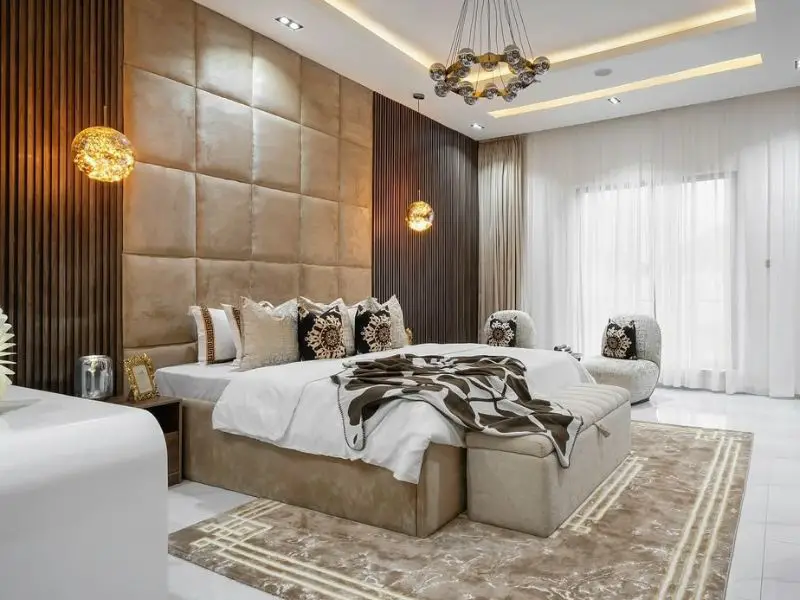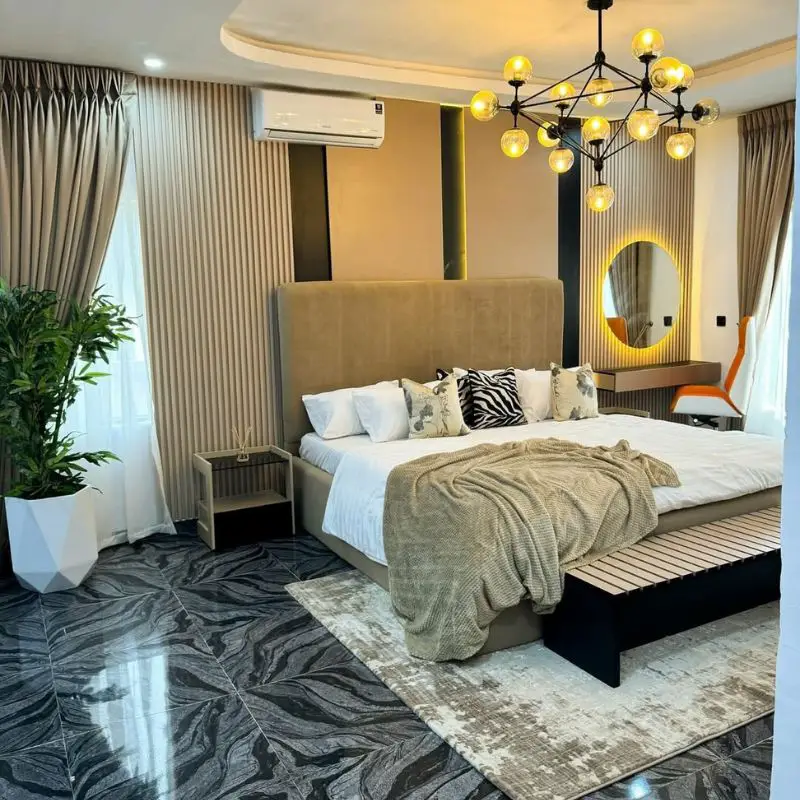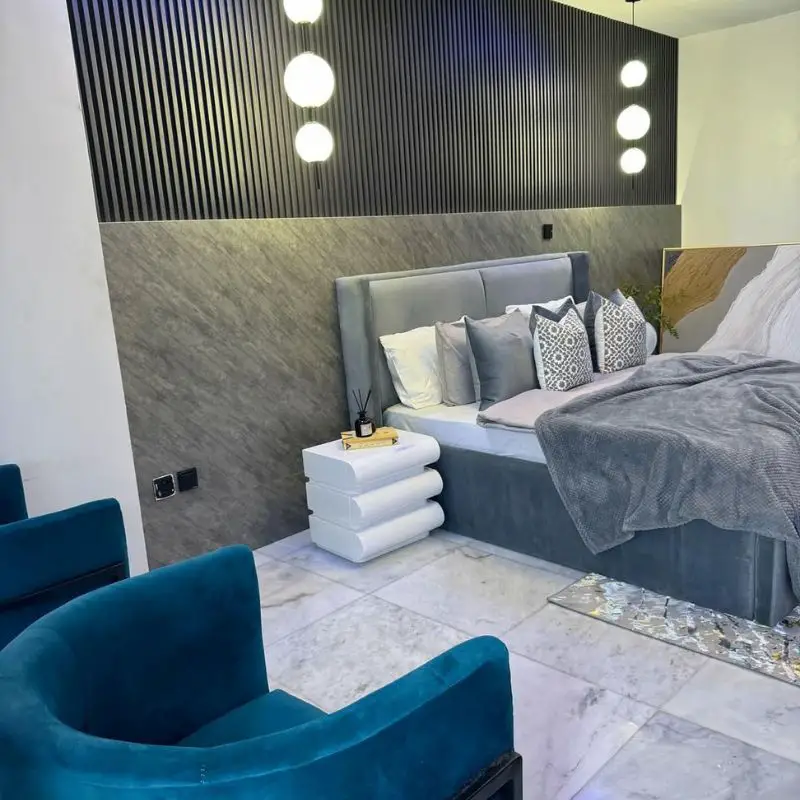What makes a space feel truly expensive without spending big? It’s all in the layering.
Here’s how to layer textures to make your home feel luxurious in the easiest, most natural way.
There was a time I started to question if I had any style or taste at all. I would scroll through Instagram, and get so inspired.
But then I’d look around my own home, and feel absolutely disconnected. It wasn’t ugly, but it didn’t feel like anything
Just a space that looked decent but felt empty. I had the furniture, the cushions, the neutral tones everyone online said looked elevated. But the space felt disconnected still.
And that started to mess with me a little. I wanted a home that felt warm, and beautiful.
It wasn’t until I visited someone’s home that felt rich in all the right ways, not expensive, but layered and lived-in, that I finally saw it.
The difference wasn’t in the size of the room, the color of the walls, or the number of throw pillows. It was in the texture.
The heavy knit throw folded softly at the foot of the bed. The smoothness of the ceramic vase against the roughness of a wooden console.
What about the warmth of layered rugs, the softness of velvet cushions mixed with linen ones.
Every corner felt considered, not curated. And, I understood luxury isn’t not only about having more.
Texture does that. It brings a quiet kind of depth that no color palette or expensive furniture can fake.
It’s what makes a room feel alive and intimate instead of cold and empty. It’s also one of the most overlooked parts of decorating a home.
If your space feels flat or almost there, chances are it’s not missing a new couch, it’s missing layers.
In this post, I’m sharing what I’ve learned, about how to layer textures to create a home that doesn’t just look luxurious, but feels like a place you never want to leave.
Because you deserve that. We all do actually.
And you know, a beautiful home isn’t just something you see. It’s something you feel in your body the moment you walk through the door.
The Art of Layering: Creating Dimension Without Clutter
Layering in interior design is one of those things that sounds fancy but is actually very simple at its core.
It just means adding depth to a space by placing different materials, textures, finishes, and objects on top of or near each other.
It’s what turns a space from flat and unfinished into something that feels full of life, like someone actually lives there.
Think of it like getting dressed on a cool day. You don’t just wear a plain t-shirt and expect to feel put together.
You add a soft cardigan, maybe a scarf, a leather bag, and a pair of boots. Each layer adds something different, warmth, style, comfort.
Interior design works the same way. You start with the basics (your walls, floors, and large furniture), and then you build in layers, rugs, curtains, throw pillows, blankets, books, baskets, ceramics, and so on.
But here’s the part most people struggle with: they’re afraid layering will make their space feel cluttered or too much.
That only happens when there’s no intention behind the mix. The key is balance.
Professional designers do this all the time. They don’t just toss in random textures to make a space look trendy.
They think about how each surface will react to light, how it will feel under your hand, and how all the elements will play together.
If the space has lots of clean lines and smooth finishes, they might throw in a chunky knit pillow or a worn wooden stool.
If everything feels too soft or beige, they’ll add something with edge, a metal lamp, a leather accent chair, a piece of stone.
The goal isn’t to fill every corner. It’s to make the space feel layered, so your eye keeps moving, your hands want to reach out and touch, and your body feels more at ease in the room.
That’s what creates a sense of luxury, not just how it looks in photos, but how it feels in real life.
So if you’re decorating your home and something feels off, try looking at the textures and layers.
Do you have too much of one thing?
Too many smooth surfaces? Too many similar fabrics? Start mixing it up. Add something unexpected.
Types of Texture in Interior Design: The Foundation of a Layered Look

Photo Credit@ li_interiors
If you’ve ever walked into a space and felt like it had soul, even if it wasn’t full of expensive things, chances are, texture had a lot to do with it.
Texture is what gives a room depth. Without it, even the prettiest space can feel flat or unfinished.
So if you’re trying to create a home that feels warm, welcoming, and luxurious, understanding the types of texture is a great place to start.
There are two main types of texture in interior design: tactile and visual.
Let’s talk about them briefly:
Tactile Textures (What You Can Physically Feel)
Tactile textures are the ones your hands can actually touch and feel a difference in. They play a huge role in how serene or refined a space feels.
Here are a few kinds to know:
- Soft Textures
These include fabrics like velvet, mohair, chenille, and faux fur. Soft textures bring warmth and comfort into a space. They’re perfect for throw pillows, blankets, upholstered furniture, and bedding. - Rough Textures
Materials like jute, raw or reclaimed wood, rattan, or concrete fall into this group. Rough textures help ground a space.
They add an organic, lived-in feel, especially helpful in rooms that feel too sterile or new.
- Smooth Textures
These include glass, lacquered finishes, polished metals, and certain tiles. Smooth textures reflect light and can make a room feel more refined or modern.
But when used too much on their own, they can make a space feel cold. That’s why mixing in softer or rougher textures helps create warmth and contrast.
Visual Textures (What You See But Don’t Necessarily Feel)
Visual textures don’t always feel different to the touch, but they look like they have depth. And that can be just as powerful in a room.
Some examples include:
- Patterns
This can be anything from a bold floral fabric to a subtle stripe or geometric rug. Patterns can create movement and energy. Even if everything in the room is smooth to the touch, a patterned fabric can visually break it up and add interest. - Embossed or Textured Wallpaper
These wallpapers may not be thick, but they look like they have raised elements, like grasscloth or linen-textured paper. They create depth on the walls without needing art or shelves. - Natural Variations
These types of visual texture bring nature indoors. A marble countertop with bold veining or a wooden cabinet with visible knots and grain can add richness and character, even if they feel smooth to the touch.
How Texture Adds Richness When Layered Right

Photo Credit@ li_interiors
When you mix different textures, both tactile and visual, you create a room that feels layered and complete. For example, imagine this:
- A soft linen sofa
- A nubby wool throw draped over the side
- A rough jute rug on the floor
- A sleek metal lamp beside it
- A patterned cushion in the corner
Individually, each item might feel simple. But together, they speak. They create contrast, balance, and comfort. That’s the power of texture.
How to Mix Textures & Fabrics in Luxury Interiors

Photo Credit@ li_interiors
One of the biggest mistakes people make when decorating is buying everything in the same fabric or finish.
A linen sofa, linen curtains, linen pillows. Or a room full of smooth, shiny surfaces. It might look clean at first, but after a while, it starts to feel flat.
That’s where texture becomes your secret design tool.
When you’re learning how to layer textures in a luxury home, the trick isn’t just using different materials, it’s mixing them in a way that feels effortless. And trust me, it’s easier than it sounds once you know what to look for.
Start with Five Core Textures
These are timeless materials that designers return to again and again, because they each bring something unique to the room.
- Linen feels breathable, relaxed, and natural. It’s perfect for sofas, curtains, or bedding when you want the space to feel airy and soft.
- Velvet adds richness and warmth. A velvet chair, cushion, or ottoman can make any corner feel a little more elegant.
- Silk has a subtle glow that instantly makes a space feel more refined. Use it in small doses, maybe as a pillow cover or lampshade lining.
- Wool brings warmth and coziness, especially in throws, rugs, or winter upholstery. It grounds the space and adds softness.
- Leather adds structure and depth. If it’s a chair, or even a leather-trimmed pillow, it helps balance out softer fabrics and makes the space feel more complete.
When you layer these thoughtfully, say, a linen sofa with velvet cushions and a leather accent chair, you create contrast and comfort at the same time. The room doesn’t just look layered, it feels layered.
Mixing Hard and Soft Surfaces for Balance

Photo Credit@ li_interiors
Textures aren’t just about fabrics. Hard materials matter too. A heavy wooden coffee table, a brushed metal lamp, or a stone side table all bring structure and contrast.
And when you pair them with soft textures like boucle, velvet, or thick knits? That contrast is what gives the room that polished, luxury feel.
Try these combinations:
- Wood + Velvet: The warmth of wood with the softness of velvet creates a grounded, elegant pairing.
- Metal + Boucle: A sleek gold side table next to a fluffy boucle chair makes both materials stand out even more.
- Glass + Wool: The slickness of glass with the comfort of wool helps the space feel both airy and warm.
This type of texture mixing is subtle, but it’s what separates a room that looks okay from one that looks designed with intention.
Use the 60-30-10 Texture Rule
If you’re not sure how to begin, follow this simple guideline to keep everything balanced:
- 60% Base Texture: Choose one main texture that forms the foundation, maybe linen or cotton upholstery, or a jute rug.
- 30% Accent Texture: Add in a second texture that supports the first but brings contrast, like a velvet cushion or a wool throw.
- 10% Surprise Texture: Finish with something unexpected. A glossy ceramic vase, a hammered brass lamp, or a leather pillow. This adds a little tension, in a good way.
How to Enhance Your Home’s Cosy Factor Through Layering

Photo Credit@ li_interiors
There’s a certain kind of comfort that makes you want to stay home just a little longer. It’s not about having a big space or expensive things, it’s about how your home feels.
And more often than not, that feeling comes from layering.
Especially in bedrooms and living rooms, the places where we unwind, recharge, and feel most ourselves.
The right layers can make all the difference. They soften the edges of a space, calm the noise of everyday life, and turn a regular room into a retreat.
Start With the Softest Essentials
Think of the first layer as your comfort base, the things that invite you to relax without even trying.
- Throws: These aren’t just for keeping warm. Drape one over the arm of your sofa, fold one neatly at the foot of your bed, or put one across a reading chair.
- Pillows: Not all throw pillows are created equal. Use a mix of fabrics, like velvet, cotton, boucle, or linen, and play with different sizes.
Don’t just think in colors; think in feeling. A velvet pillow brings warmth. A linen one feels light and breezy. Together, they tell a layered, thoughtful story.
- Rugs: Even if you already have hardwood or tile floors, a rug grounds the space and makes it feel more inviting. Layering a flatweave under a plush rug adds even more comfort underfoot and gives visual depth.
These pieces work like a gentle hug for the room. They’re what make you curl your toes into the rug on a cold morning or settle deeper into the sofa after a long day.
Bring the Walls and Windows Into the Experience
Layering doesn’t stop with furniture. Walls and windows play a huge role in how a room feels, and they’re often overlooked.
- Drapery: Thick, full curtains in textured fabrics like linen, velvet, or wool help control light and create softness.
Even in bright, airy homes, layered window treatments (like sheers under heavier panels) can add richness without taking away from the natural light.
- Upholstery: If you’re updating furniture, don’t just think in terms of color, think texture.
A linen headboard, a boucle armchair, or a velvet bench can become subtle anchors for your space. This is how to layer textures without overwhelming the room: focus on tactile contrast that feels intentional, not crowded.
Engage More Than Just Sight and Touch
One powerful part of creating a cosy home that people rarely talk about is scent. It’s invisible, but it deeply affects how you experience a space.
Soft textures might welcome your body, but a warm scent welcomes your mind.
- Candles: Choose scents that match the mood you want to create amber, vanilla, cedarwood, or soft florals.
- Essential oils: Diffusing oils like lavender or sandalwood can instantly make a room feel more serene and grounded.
- Scented linens: Lightly misting your curtains, throws, or pillowcases with a fabric spray can carry that sense of comfort into the smallest moments.
These finishing touches aren’t just extras, they round out the experience, helping your space feel luxurious in a quiet, almost subconscious way.
How to Layer Textures in Interior Design Without Overdoing It

Photo Credit@ li_interiors
Sometimes, the biggest mistake in home styling comes from trying too hard.
So let’s walk through how to layer textures in interior design the right way, without making your space feel chaotic or heavy.
Why Less Is Often More
When you’re learning how to layer textures, it’s tempting to fill every surface with something interesting.
A fluffy throw here, a furry pillow there, a chunky knit, plus rattan, wood, velvet, and brass, before you know it, the room feels loud instead of luxurious.
Here’s the truth: not every corner needs a statement. The most high-end interiors feel calm, not crowded.
Restraint is a design skill. Professional designers know how to make a room feel full without overwhelming the senses and that starts by giving the eye a place to rest.
Pick 2 to 3 Main Textures
One of the easiest ways to keep your space balanced is to stick to two or three key textures that anchor the room.
This works especially well in homes with a neutral color palette. For example:
- A linen sofa as your base (smooth and soft)
- A chunky knit throw for contrast (cozy and tactile)
- A raw wood coffee table for a natural element (earthy and grounding)
You don’t need ten different materials to create depth. With just a few well-chosen layers, you can achieve richness without the mess.
Let the Room Breathe
This is where negative space becomes your best friend. Empty areas, blank walls, clean tabletops, even bare floor patches, are not mistakes. They’re what allow the textured pieces you do have to shine.
Think of layering textures like creating music. You need highs, lows, and pauses. A room full of non-stop sound is exhausting. A room with moments of quiet makes the beats (your textures) stand out beautifully.
So when deciding how to layer textures, always ask: Do I need something here, or does it already feel complete?
Quick Tips to Keep It Balanced
Photo Credit@ li_interiors
- If you’re layering a soft rug over wood floors, skip the super-textured cushions on the couch. Let the rug speak.
- When using a bold texture (like leather or velvet), tone down the rest with smoother, quieter finishes.
- Group textures in small doses, like two boucle pillows on one end of the couch, rather than scattering them all over.
Stylish Layering in Interior Design: Where to Start and What to Avoid
One of the most common questions people ask when decorating their homes is, “How do I make it feel stylish but not overwhelming?”
It’s easy to see a beautiful living room online and think, “I want that,” but when you try to recreate it, the results can feel off, either too flat or way too much.
That’s where learning how to layer textures thoughtfully comes in. But the truth is, the right approach often depends on your personal style.
Whether you love the look of sleek modern glam or soft rustic vibes, layering is what turns a basic room into one that feels elevated, lived-in, and truly yours.
Let’s break it down by style, so you know where to begin, and just as importantly, what to avoid.
Modern Glam
This style is all about confidence, high-gloss finishes, soft plush fabrics, touches of metallic, and a little bit of sparkle.
Think velvet accent chairs, gold or chrome side tables, and mirrors that bounce the light around the room.
How to Layer Textures Here:
Balance is key. Pair shiny surfaces like lacquered furniture or polished marble with something softer and more grounded like a shaggy rug or crushed velvet.
If everything is shiny, nothing stands out, so always balance gloss with matte.
What to Avoid:
Don’t go overboard with metallics. One or two gold or mirrored pieces per room is enough. Also, avoid synthetic-looking fabrics that feel stiff or overly fake, they take away from the glamour rather than add to it.
Rustic Luxe
If you love warm, natural spaces that feel cosy but elevated, this is your lane. Think raw wood beams, soft shearling throws, aged leather sofas, and handwoven textures.
How to Layer Textures Here
Start with your base, usually something earthy like a wood floor or jute rug.
Add depth with textures like wool, chunky knits, or a linen slipcover. Then, sneak in a little luxury, like a cashmere throw or antique brass lamp, to raise the tone without changing the vibe.
What to Avoid:
Don’t make everything look too raw or overly rustic. Without at least one refined element (like a velvet cushion or sleek lamp), the space can look unfinished.
Also, avoid faux-weathered finishes that look forced. Authenticity is what makes this style work.
Minimalist Chic
This style gets misunderstood a lot. It’s not about having less, but about being intentional. Its clean lines, soft neutral colors, matte finishes, and tone-on-tone textures.
How to Layer Textures Here:
Because you’re working with fewer colors, texture becomes your tool for creating depth.
A room might be all beige or all white, but the materials should still vary cotton, linen, wool, leather.
That’s how to layer textures in a minimalist space without breaking the calm vibe.
What to Avoid:
Don’t confuse minimal with cold. If everything in the room is smooth and hard, glass, metal, or plastic it starts to feel sterile.
Always include at least one warm element like a textured throw or wooden accent to soften things up.
Common Mistake to Watch Out For
No matter your style, there are a few traps that can make even the most well-designed rooms fall flat:
- Too Many Statement Pieces: A velvet couch, patterned rug, sculptural light, and bold art if everything’s loud, nothing shines.
Choose one or two focal points and let the rest support them.
- Clashing Patterns: Patterns are a type of visual texture, and too many of them layered together can overwhelm the eye.
Stick to a similar color family or vary the scale (small pattern + large pattern) to keep things balanced.
- Poor Lighting: Even if your textures are layered perfectly, they won’t look right in dim or uneven light.
Mix overhead lighting with floor lamps, wall sconces, and candles to highlight the textures you’ve worked so hard to layer.
Leave a Reply